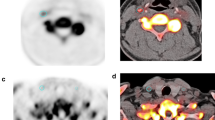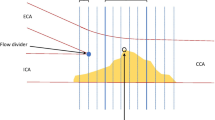Abstract
Objectives
Non-stenotic plaques are an underestimated cause of ischemic stroke. Imaging aspects of high-risk carotid plaques can be identified on CT angiography (CTA) and 18F-fluoro-deoxyglucose positron emission tomography (FDG-PET) imaging. We evaluated in patients with cryptogenic ischemic stroke the usefulness of FDG-PET-CTA.
Methods
44 patients imaged with CTA and FDG-PET were identified retrospectively. Morphological features were identified on CTA. Intensity of FDG uptake in carotid arteries was quantified on PET.
Results
Patients were imaged 7 ± 8 days after stroke. 44 non-stenotic plaques with increased 18F-FDG uptake were identified in the carotid artery ipsilateral to stroke and 7 contralateral. Most-diseased-segment TBR on FDG-PET was higher in artery ipsilateral vs. contralateral to stroke (2.24 ± 0.80 vs. 1.84 ± 0.50; p < .05). In the carotid region with high FDG uptake, prevalence of hypodense plaques and extent of hypodensity on CTA were higher in artery ipsilateral vs. contralateral to stroke (41% vs. 11%; 0.72 ± 1.2 mm2 vs. 0.13 ± 0.43 mm2; p < .05).
Conclusions
In patients with ischemic stroke of unknown origin and non-stenotic plaques, we found an increased prevalence of high-risk plaques features ipsilateral vs. contralateral to stroke on FDG-PET-CTA imaging suggesting a causal role for these plaques.



Similar content being viewed by others
Abbreviations
- CTA:
-
Computed tomographic angiography
- FDG:
-
Fluorodeoxyglucose
- MDS:
-
Most-diseased segment
- PET:
-
Positron emission tomography
- TBR:
-
Tissue to background ratio
References
Zhang Y, Chapman AM, Plested M, Jackson D, Purroy F. The incidence, prevalence, and mortality of stroke in France, Germany, Italy, Spain, the UK, and the US: A literature review. Stroke Res Treat 2012;2012:436125.
Guzik A, Bushnell C. Stroke epidemiology and risk factor management. Continuum (Minneap Minn) 2017;23:15–39.
Freilinger TM, Schindler A, Schmidt C, Grimm J, Cyran C, et al. Prevalence of nonstenosing, complicated atherosclerotic plaques in cryptogenic stroke. J Am Coll Cardiol Img 2012;5:397–405.
Amarenco P. Underlying pathology of stroke of unknown cause (cryptogenic stroke). Cerebrovasc Dis 2009;27:97–103.
Li L, Yiin GS, Geraghty OC, Schulz UG, Kuker W, Mehta Z, et al. Incidence, outcome, risk factors, and long-term prognosis of cryptogenic transient ischaemic attack and ischaemic stroke: A population-based study. Lancet Neurol 2015;14:903–13.
Redgrave JN, Lovett JK, Gallagher PJ, Rothwell PM. Histological assessment of 526 symptomatic carotid plaques in relation to the nature and timing of ischemic symptoms: The Oxford plaque study. Circulation 2006;113:2320–8.
Brinjikji W, Huston J 3rd, Rabinstein AA, Kim GM, Lerman A, Lanzino G. Contemporary carotid imaging: From degree of stenosis to plaque vulnerability. J Neurosurg 2016;124:27–42.
Alonso A, Artemis D, Hennerici MG. Molecular imaging of carotid plaque vulnerability. Cerebrovasc Dis 2015;39:5–12.
Gupta A, Gialdini G, Lerario MP, Baradaran H, Giambrone A, Navi BB, et al. Magnetic resonance angiography detection of abnormal carotid artery plaque in patients with cryptogenic stroke. J Am Heart Assoc 2015. https://doi.org/10.1161/JAHA.115.002012.
Zhao H, Zhao X, Liu X, Cao Y, Hippe DS, Sun J, et al. Association of carotid atherosclerotic plaque features with acute ischemic stroke: A magnetic resonance imaging study. Eur J Radiol 2013;82:e465–70.
Ge X, Zhou Z, Zhao H, Li X, Sun B, Suo S, et al. Evaluation of carotid plaque vulnerability in vivo: Correlation between dynamic contrast-enhanced MRI and MRI-modified AHA classification. J Magn Reson Imaging 2017. https://doi.org/10.1002/jmri.25637.
Powers WJ, Derdeyn CP, Biller J, Coffey CS, Hoh BL, Jauch EC, et al. 2015 American Heart Association/American Stroke Association Focused Update of the 2013 Guidelines for the early management of patients with acute ischemic stroke regarding endovascular treatment a guideline for healthcare professionals from the American Heart Association/American Stroke Association. Stroke 2015;46:3020–35.
Wintermark M, Jawadi SS, Rapp JH, Tihan T, Tong E, Glidden DV, et al. High-Resolution CT Imaging of Carotid Artery Atherosclerotic Plaques. Am J Neuroradiol 2008;29:875–82.
Trelles M, Eberhardt KM, Buchholz M, Schindler A, Bayer-Karpinska A, Dichgans M, et al. CTA for screening of complicated atherosclerotic carotid plaque American Heart Association Type VI lesions as defined by MRI. AJNR Am J Neuroradiol 2013;34:2331–7.
Gupta A, Baradaran H, Kamel H, Pandya A, Mangla A, Dunning A, et al. Evaluation of computed tomography angiography plaque thickness measurements in high-grade carotid artery stenosis. Stroke 2014;45:740–5.
Walker LJ, Ismail A, McMeekin W, Lambert D, Mendelow AD, Birchall D. Computed tomography angiography for the evaluation of carotid atherosclerotic plaque: Correlation with histopathology of endarterectomy specimens. Stroke 2002;33:977–81.
Figueroa AL, Subramanian SS, Cury RC, Truong QA, Gardecki JA, Tearney GJ, et al. Distribution of inflammation within carotid atherosclerotic plaques with high-risk morphological features: A comparison between positron emission tomography activity, plaque morphology, and histopathology. Circ Cardiovasc Imaging 2012;5:69–77.
Hyafil F, Schindler A, Sepp D, Obenhuber T, Bayer-Karpinska A, Boeckh-Behrens T, et al. High-risk plaque features can be detected in non-stenotic carotid plaques of patients with ischaemic stroke classified as cryptogenic using combined 18F-FDG PET/MR imaging. Eur J Nucl Med Mol Imaging 2016;43:270–9.
Kamel H, Navi BB, Merkler AE, Baradaran H, Díaz I, Parikh NS, et al. Reclassification of ischemic stroke etiological subtypes on the basis of high-risk nonstenosing carotid plaque. Stroke 2020;51: 504–10.
Zhao X, Hippe DS, Li R, Canton GM, Sui B, Song Y, et al. Prevalence and characteristics of carotid artery high-risk atherosclerotic plaques in Chinese patients with cerebrovascular symptoms: A Chinese atherosclerosis risk evaluation II study. J Am Heart Assoc 2017;6:e005831.
Ali A, Tawakol A. FDG PET/CT imaging of carotid atherosclerosis. Neuroimaging Clin N Am 2016;26:45–54.
Sharma VK, Paliwal PR, Sinha AK. Plaque inflammation imaging in severe carotid stenosis and recurrent cerebral ischemia. J Nucl Med Technol 2015;43:299–300.
Skagen K, Johnsrud K, Evensen K, Scott H, Krohg-Sørensen K, Reier-Nilsen F, et al. Carotid plaque inflammation assessed with (18)F-FDG PET/CT is higher in symptomatic compared with asymptomatic patients. Int J Stroke 2015;10:730–6.
Rominger A, Saam T, Wolpers S, Cyran CC, Schmidt M, Foerster S, et al. 18F-FDG PET/CT identifies patients at risk for future vascular events in an otherwise asymptomatic cohort with neoplastic disease. J Nucl Med 2009;50:1611–20.
Marnane M, Merwick A, Sheehan OC, Hannon N, Foran P, Grant T, et al. Carotid plaque inflammation on 18F-fluorodeoxyglucose positron emission tomography predicts early stroke recurrence. Ann Neurol 2012;71:709–18.
Vesey AT, Jenkins WS, Irkle A, Moss A, Sng G, Forsythe RO, et al. 18F-fluoride and 18F-fluorodeoxyglucose positron emission tomography after transient ischemic attack or minor ischemic stroke: Case-control study. Circ Cardiovasc Imaging 2017;10:e004976.
Soussan M, Nicolas P, Schramm C, Katsahian S, Pop G, Fain O, Mekinian A. Management of large-vessel vasculitis with FDG-PET: A systematic literature review and meta-analysis. Medicine (Baltimore) 2015;94:e622.
Lariviere D, Benali K, Coustet B, Pasi N, Hyafil F, Klein I, et al. Positron emission tomography and computed tomography angiography for the diagnosis of giant cell arteritis: A real-life prospective study. Medicine (Baltimore) 2016;95:e4146.
Emsen B, Benali K, Mahida B, Larivière D, Le Guludec D, Papo T, et al. Comparison between visual and numerical metrics for the evaluation of patients with Takayasu arteritis with 18F-FDG-PET. Nucl Med Commun 2018;39:779–88.
Sinigaglia M, Mahida B, Piekarski E, Chequer R, Mikail N, Benali K, et al. FDG atrial uptake is associated with an increased prevalence of stroke in patients with atrial fibrillation. Eur J Nucl Med Mol Imaging 2019;46:1268–75.
Author information
Authors and Affiliations
Corresponding author
Additional information
Publisher's Note
Springer Nature remains neutral with regard to jurisdictional claims in published maps and institutional affiliations.
The authors of this article have provided a PowerPoint file, available for download at SpringerLink, which summarises the contents of the paper and is free for re-use at meetings and presentations. Search for the article DOI on SpringerLink.com.
Supplementary Infromation
Below is the link to the electronic supplementary material.
Rights and permissions
About this article
Cite this article
Mikail, N., Meseguer, E., Lavallée, P. et al. Evaluation of non-stenotic carotid atherosclerotic plaques with combined FDG-PET imaging and CT angiography in patients with ischemic stroke of unknown origin. J. Nucl. Cardiol. 29, 1329–1336 (2022). https://doi.org/10.1007/s12350-020-02511-8
Received:
Accepted:
Published:
Issue Date:
DOI: https://doi.org/10.1007/s12350-020-02511-8




